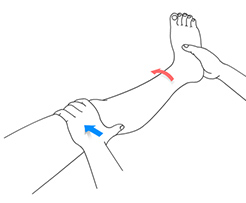What is an ACL Injury?
The ACL (anterior cruciate ligament) is one of the four major ligaments located within the knee joint. It connects the femur (thighbone) to the tibia (shinbone). It plays a key role in holding the two bones within the knee and keeping the joint stable while your knee moves back and forth.
An ACL injury is a sprain or a tear (total or partial) to the ligament. Young people involved in sports such as basketball, football, soccer and gymnastics are more prone to ACL injuries due to sudden changes in direction, acceleration, deceleration and repetitive movements.

Symptoms of ACL Injuries
The most common signs and symptoms of ACL injuries include:
- Pop in the knee heard when injury occurs
- Painful and/or swollen knee
- Tenderness at the joint
- Unstable or loose knee
- Less range of motion
- Discomfort with walking
Diagnosis of ACL Injuries
Your doctor will review your child’s symptoms and the nature of the injury. A physical examination is performed comparing the injured and non-injured knee. Imaging tests such as an X-ray or MRI may be ordered to visualize the structures of the knee joint and determine the extent of injury.
Nonoperative Treatments of ACL Injuries
Nonoperative treatments may be recommended if your child has a minor ACL injury, is still growing and does not wish to immediately return to sports.
Conservative treatment is likely to be effective if your child:
- Has an ACL tear or injury that is partial
- Has no instability symptoms
- Does not actively participate in sports
Immediate care following an ACL injury includes the RICE protocol: Resting, Icing, Compression and Elevation of the injured knee. Medications are prescribed to control pain and inflammation.
To further treat the ACL injury, your doctor may recommend nonoperative methods such as rehabilitation, knee bracing, and activity restriction.
Rehabilitation
Rehabilitation involves a structured and progressive physical therapy involving exercises to strengthen the muscles around your knee. The program may help your child regain and restore knee strength, motion, and function close to its pre-injury state.
Knee Bracing
Knee bracing in the form of a hinged brace may be recommended for a few weeks concurrently with the rehabilitation program. It supplements the physical therapy and protects your knee from instability. The brace limits the range of knee motion thus protecting the ACL and allowing it to heal. You may also be given crutches to take the load off your knee.
Activity Restriction
Your child may have to modify activities to ensure that the ACL is not further injured and has an opportunity to heal. For moderate injuries treated nonoperatively, your child may be encouraged to participate in sports and activities that are physically less demanding.
Prevention
Proper training to improve posture when performing pivoting and cutting movements as well as jumping can help reduce the risk of ACL injury during sports.





